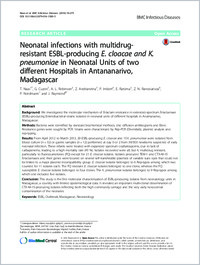Neonatal infections with multidrug-resistant ESBL-producing E. cloacae and K. pneumoniae in Neonatal Units of two different Hospitals in Antananarivo, Madagascar
- Naas, Thierry Bacteriologie, APHP, EA7361 Univ Paris Sud, Le Kremlin-Bicetre, France
- Cuzon, Gaëlle Bacteriologie, APHP, EA7361 Univ Paris Sud, Le Kremlin-Bicetre, France
- Robinson, A. L. Service de Pédiatrie, Hôpital Tsaralanana, Antananarivo, Madagascar
- Andrianirina, Z. Service de Néonatologie, Hôpital Soavinandriana, Antananarivo, Madasgasca
- Imbert, P. Hôpital Begin, Vincennes, France
- Ratsima, E. Institut Pasteur, Antananarivo,Madagascar
- Ranosiarisoa, Z. N. Service de Néonatologie, Hôpital Befelatanana, Antananarivo, Madagascar
- Nordmann, Patrice Medical Microbiology, Fribourg Univ, Fribourg, Switzerland
- Raymond, J. University Paris Descartes Bacteriologie, Hôpital Cochin, Paris, France
-
10.06.2016
Published in:
- BMC Infectious Diseases. - 2016, vol. 16, p. 275
English
Background: We investigated the molecular mechanism of ß-lactam resistance in extended-spectrum ß-lactamase (ESBL)-producing Enterobacterial strains isolated in neonatal units of different hospitals in Anatnanarivo, Madagascar.Methods: Bacteria were identified by standard biochemical methods, disc diffusion antibiograms and Etest. Resistance genes were sought by PCR. Strains were characterized by Rep- PCR (Diversilab), plasmid analysis and rep-typing.Results: From April 2012 to March 2013, 29 ESBL-producing E. cloacae and 15 K. pneumoniae were isolated from blood culture (n = 32) or gastric samples (n = 12) performed at day 0 or 2 from 39/303 newborns suspected of early neonatal infection. These infants were treated with expanded spectrum cephalosporins, due to lack of carbapenems, leading to a high mortality rate (45 %). Isolates recovered were all, but 4, multidrug resistant, particularly to fluoroquinolones (FQ) except for 21 E. cloacae isolates. Isolates produced TEM-1 and CTX-M-15 ß-lactamases and their genes were located on several self- transferable plasmids of variable sizes sizes that could not be linked to a major plasmid incompatibility group. E. cloacae isolates belonged to 6 Rep-types among which two counted for 11 isolates each. The FQ resistant E. cloacae isolates belonged to one clone, whereas the FQ susceptible E. cloacae isolates belonged to four clones. The K. pneumoniae isolates belonged to 9 Rep-types among which one included five isolates.Conclusion: This study is the first molecular characterization of ESBL- producing isolates from neonatology units in Madagascar, a country with limited epidemiological data. It revealed an important multi-clonal dissemination of CTX-M-15- producing isolates reflecting both the high community carriage and the very early nosocomial contamination of the neonates.
- Faculty
- Faculté des sciences et de médecine
- Department
- Médecine 3ème année
- Language
-
- English
- Classification
- Biological sciences
- License
-
License undefined
- Identifiers
-
- RERO DOC 277408
- DOI 10.1186/s12879-016-1580-5
- Persistent URL
- https://folia.unifr.ch/unifr/documents/305086
Statistics
Document views: 113
File downloads:
- pdf: 181
